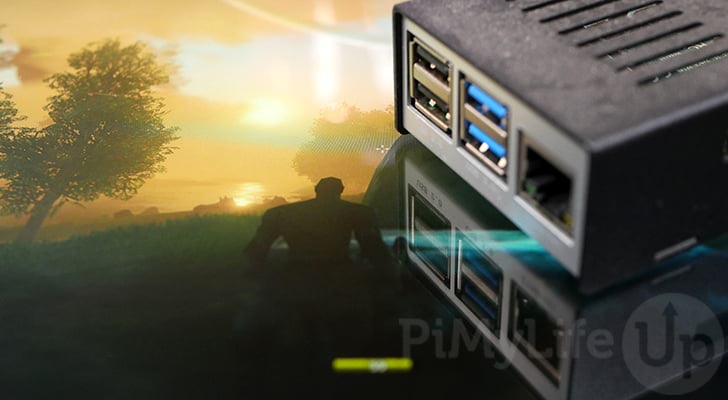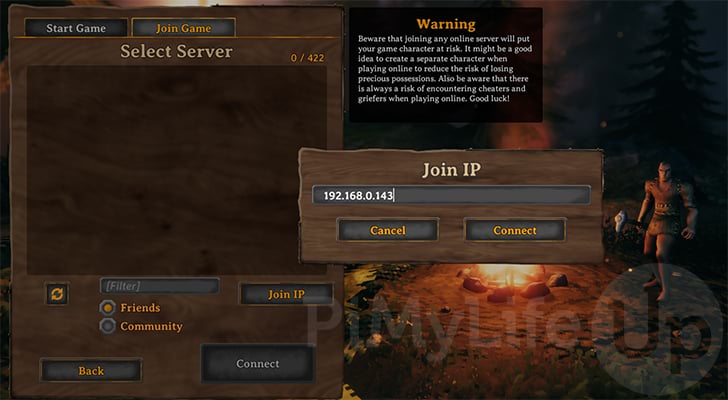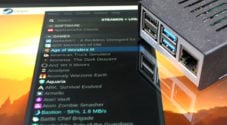In this project, we will be showing you how you can set up a dedicated Valheim server on the Raspberry Pi.

Valheim is a hardcore survival and sandbox video game that takes place within a fictional world for slain Vikings proving themselves fit for Valhalla. The game involves you crafting, building, and fighting to survive.
The game even features support for multiplayer with up to ten other players. Of course, this multiplayer support is where your Raspberry Pi comes in handy.
Within this guide, you will be shown how to run a dedicated Valheim server directly on the Raspberry Pi.
The Pi proves itself to be a reasonably capable device for running the Valheim server software, especially when paired with a fast SD card or USB 3.0 device.
While the Valheim server hasn’t been natively compiled for the Pi’s ARM architecture, we can use a couple of pieces of software to get it to run.
Before we go any further, you will need to use a Raspberry Pi 4 or newer for this project. The software that we will be relying on to run the Valheim dedicated server does not currently work on older Pi’s.
Equipment
Below is a list of the equipment we used when setting up a Valheim server on our Raspberry Pi.
Recommended
Optional
We tested this tutorial on a Raspberry Pi 400 running the latest version of Raspberry Pi OS Lite (Buster).
Setting up your Raspberry Pi for the Valheim Server
Please note that to run a Valheim server on your Raspberry Pi, you need to use a 64-bit operating system. Therefore, for this guide, we will be focusing on using the 64-bit release of Raspberry Pi OS.
To maximize the performance of your Valheim server, we highly recommend setting your Raspberry Pi up as headless.
As the Valheim development team hasn’t provided an ARM build of their server, we must do a few things to get it to run on our Raspberry Pi.
Installing the x86 and x64 Emulators to the Raspberry Pi
We will need to use both an x86 and x64 emulator within this guide as the software we are using isn’t natively built for the Pi’s ARM architecture.
The “SteamCMD” software will require us to install “box86“, and the Valheim dedicated server will need us to use “box64“.
1. First off, we need to install Box86 to our Raspberry Pi. This piece of software will allow us to run the “SteamCMD” software on our device.
SteamCMD is what we will use to download the latest version of the Valheim dedicated server to our Raspberry Pi.
To compile and install this software, please follow our guide on using Box86 on the Raspberry Pi. If you are using a Raspberry Pi 5 you will also need to follow the “troubleshooting” instructions on that page.
2. Once you have installed Box86, you will also need to install Box64. This software is similar to Box86 but is used to run x64 software on our ARM64 device.
This software will let us run the Valheim dedicated server on our Raspberry Pi as there are no native builds for ARM.
Make sure to follow our guide on installing Box64 to the Raspberry Pi before continuing any further with this guide.
Setting up SteamCMD on the Pi
With Box86 and Box64 installed on your Raspberry Pi. we can now move on to installing the final piece of the puzzle.
To download the Valheim dedicated server on our Raspberry Pi, we need to use the Steam command-line tool called “steamcmd“.
The following steps will walk you through the process of installing and running SteamCMD on your Raspberry Pi.
1. Our first step is to make a directory where we will store the SteamCMD software. In our case, we will keep this within a directory called “steamcmd” in our “pi” users home directory.
You can make this directory and change to it on your Raspberry Pi by using the following commands on your device.
mkdir ~/steamcmd
cd ~/steamcmdCopy2. Now that we are in the directory, we can download and extract SteamCMD using the command below.
This command will use curl to download the file and pass it straight into the tar tool using a pipe (|). A pipe allows us to extract the data provided from curl in a single command.
curl -sqL "https://steamcdn-a.akamaihd.net/client/installer/steamcmd_linux.tar.gz" | tar zxvf -Copy3. Before installing the Valheim dedicated server to our Raspberry Pi, let us ensure that SteamCMD is now working.
We can verify that the software is working correctly by running the script with the command below.
./steamcmd.shCopyDuring the first run of the “steamcmd” software, it will self-update and prepare itself for use.
4. Once SteamCMD finishes updating, you can quit out of the tool by using the following command on your device.
quitCopyInstalling the Valheim Server on the Raspberry Pi
Now that we have prepared our Raspberry Pi, we can install the Valheim dedicated server.
To achieve this, we will be using the SteamCMD tool that we set up in the previous section to download the latest release.
1. Make sure that we are in the same directory as where we downloaded SteamCMD by using the following command.
cd ~/steamcmdCopy2. Now that we are in the correct location, we can use SteamCMD to download the Valheim dedicated server.
You can use SteamCMD to begin downloading the server by using the following command.
./steamcmd.sh +force_install_dir ~/valheim_server +@sSteamCmdForcePlatformType linux +login anonymous +app_update 896660 validate +quitCopyWith this, we are issuing several different commands to the Steam command line. We will quickly go through this, so you have an idea of what everything does.
+@sSteamCmdForcePlatformType linux– Using this part of the command, we are forcing the platform type to Linux.
This stops the command line tool from picking an incorrect platform.+login anonymous– This option will log us into the Steam network as an “anonymous” user.
The anonymous doesn’t require a password, so it is helpful for downloading openly available software.+force_install_dir /home/pi/valheim_server– Using this option, SteamCMD allows us to choose where we want the server installed.
In our case, we will install the Valheim dedicated server to “/home/pi/valheim_server“.+app_update 896660– This part is what allows us to select what we want to download.
In this case, “896660” is the app ID for the Valheim dedicated server.
3. Our next step is to modify the start server script for Valheim so that you can configure it to best suit your needs.
Begin editing the “start_server.sh” script by using the nano text editor with the following command.
nano ~/valheim_server/start_server.shCopy4. Within this file, you will want to replace one line in particular. This is the line that will start the Valheim dedicated server on our Raspberry Pi.
You can use CTRL + W within nano to search for this line.
./valheim_server.x86_64 -name "My server" -port 2456 -world "Dedicated" -password "secret"CopyOnce you have found the above line, replace it with the following.
./valheim_server.x86_64 -nographics -batchmode -port 2456 -public 0 -name "My Server Name" -world "MyWorldName" -password "MySecretPassword" -savedir "./valheim_data"CopyWhen typing in this new line, you may want to change a couple of options. We will quickly go through them now.
-port 2456– The port option specifies what port the Valheim dedicated server will listen on. Typically it is safe to keep this set to the default unless another program is using it.
If you are behind a firewall, you will need to make sure that you port forward this port.-public 0– Using this option, you can decide whether you want your server to appear in the in-game server browser.
The default value for this option is0, meaning it will not be listed. Set this to1if you want it listed in the browser.-name "My Server Name"– This option stores the name you want your server to use when listed within the server browser.-word "MyWorldName"– Use this option to specify the name of your Valheim world.
Make sure that this name does not contain any file extensions such as “.db” or “.fwl“.-password "MySecretPassword"– You can use this option to specify a password a user must enter to log in to the game world. This option is optional and can be removed.
When entering your password, make sure that it contains at least 5 characters.
-savedir "/home/pi/valheim_data"– With this option, we specify where we want our Valheim world data saved on our Raspberry Pi.
By default, we will save this world within a directory in our “pi” user’s home called “valheim_data“.
5. Once you have made these changes to the file, you can save and quit by pressing CTRL + X, then Y, followed by the ENTER key.
Running your Raspberry Pi Valheim Dedicated Server
Now that we have installed and configured our Valheim server on the Raspberry Pi, we can run it using a single command.
As we modified the “start_server.sh” script earlier, the server will be created with your
1. To start the Valheim server on our Raspberry Pi, we need to make sure that we are in the directory where we installed it earlier.
Change into the correct directory by using the following command on your device.
cd ~/valheim_server/Copy2. Once we are in the correct director,y we can start up the Valheim dedicated server by using the following command.
By using this command, we will start the server using the options we set earlier.
./start_server.shCopyPlease note, the Valheim servers start-up process can take considerable time to complete. This is because it needs to generate the game world, location list, and various other things.
3. To connect to your server, you can use the “Join by IP” option within Valheim.
If you don’t know the local IP address of your Raspberry Pi, you can retrieve it using the hostname command.
hostname -ICopy
4. If you have finished with the Valheim server, you can quit out of it by pressing CTRL + C.
By pressing these keys, the server will close all connections, save the world and then shut down.
Getting the Valheim Server to Start at Boot
To get the Valheim server to start at boot on our Raspberry Pi, we must create a service file.
For this file, you will need to remember the options you set earlier when you modified the “start_server.sh” script earlier.
1. We can begin creating this new service by using the following command on your device.
This new service that we are creating will be named “valheim“.
sudo nano /etc/systemd/system/valheim.serviceCopy2. Within this file, you need to enter the following lines. These lines define the service and how the Valheim server should be started.
Ensure that you replace “<USERNAME>” with the name of your user.
[Unit]
Description=Valheim Dedicated Server
Wants=network-online.target
After=network-online.target
[Service]
Environment=SteamAppId=892970
Environment=LD_LIBRARY_PATH=/home/<USERNAME>/valheim_server/linux64:$LD_LIBRARY_PATH
Type=simple
Restart=on-failure
RestartSec=10
KillSignal=SIGINT
User=<USERNAME>
Group=<USERNAME>
WorkingDirectory=/home/<USERNAME>/valheim_server
ExecStart=/home/<USERNAME>/valheim_server/valheim_server.x86_64 -nographics -batchmode -port 2456 -public 0 -name "My Server Name" -world "MyWorldName" -password "MySecretPassword" -savedir "/home/<USERNAME>/valheim_data"
[Install]
WantedBy=multi-user.target
CopyWhile typing in these new lines, you will need to make sure you modify the “ExecStart” line to reflect the same options you used with the “start_server.sh” file you modified earlier.
3. Once you have finished creating the service, save and quit by pressing CTRL + X, then Y, and finally the ENTER key.
4. You can enable the Valheim server to start at boot on your Raspberry Pi by enabling the service that we just created.
Enable our new “valheim” service by using the following command.
sudo systemctl enable valheimCopy5. Instead of waiting until our Raspberry Pi restarts for the service to start, we can manually start it ourselves.
To manually start the “valheim” service, you need to use the command below.
sudo systemctl start valheimCopy6. It is possible to check the status of the Valheim service to ensure that it is running.
Run the command below on your device to retrieve the status of the service.
sudo systemctl status valheimCopyIf your Valheim dedicated server is running correctly, you should see the status marked as “Active: active (running)“.
Updating your Valheim Server on the Raspberry Pi
Updating your Valheim dedicated server is a reasonably straightforward process and mainly involves us using the “steamcmd” tool that we set up earlier in this guide.
1. Before you continue, you must ensure that your server is stopped. You can’t update the Valheim server when it’s currently in use.
Using our service, you can stop the Valheim dedicated server by using the command below.
sudo systemctl stop valheimCopy2. Once you have stopped the server, it is possible to update the dedicated server by typing in the following command.
This command will call the “steamcmd” tool and force it to update the software to the latest available version.
/home/$USER/steamcmd/steamcmd.sh +@sSteamCmdForcePlatformType linux +login anonymous +force_install_dir /home/pi/valheim_server +app_update 896660 +quitCopy3. Your server now should be updated to the latest version. There is a chance that the update process overrides the “start_server.sh” script, so you may need to change this file again if you aren’t using the service.
If you use the service we created in the previous section, you can now start it back up by running the following command.
sudo systemctl start valheimCopyConclusion
At this point in the guide, you should now have the Valheim dedicated server up and running on your Raspberry Pi.
The Pi operates as a relatively capable and energy-efficient way of running a Valheim server. As a result, you should have a decent experience gaming on the server, with the only hitching we experienced being during the start-up and saving process.
If you have run into any issues with getting the Valheim dedicated server running on your Pi, you can leave a comment below.
You can also check out our other gaming projects or learn what other servers you can run on your Raspberry Pi.










First of all, thanks for the guide! All worked great! I’m very new to linux but lately been messing about a bit with my pi5 8gb.
Apart from having to open the port on the router and allow it on the pi’s firewall aswell, it all was just a smooth ride. I did -for now- however not to make the auto start service file though.
Being in a new world, 2 people get the pi5’s cpu to about 30-40%. Not sure how much more it’ll climb once more stuff will be built and bosses will be fought :D. Anyhow again, great guide! Very user friendly. The very last step about updating the serverfiles, didn’t mention you have to adjust “pi” in the path to your own pi’s name though, but figured that out fast enough. Just some feedback on that.
Hey !
first of all, thanks for your very detailed tuto, you did a great job.
But, even with this I couldn’t correctly execute the valheim server, indeed everytime I ran it, I was disconnect at 5-10 min top. With or without friends, then I was not able to reco (“unable to connect”), I had to restart the server every time, then it disconnect … etc.
Then I see a reddit post (https://www.reddit.com/r/valheim/comments/199z0qd/dedicated_server_disconnects_after_a_couple_of/) and someone suggest to edit the /etc/box64.box64rc file, and since I did, I’m playing non stop ; I still need to test it with my friend but that’s very encouraging ! At least that is something to look …
bye !
When I start the server I got some error messages.. Are those bad?
Using emulated /home/huibl/valheim_server/valheim_server_Data/Plugins/libparty.so
Using native(wrapped) libatomic.so.1
Error initializing native libpulse.so.0 (last dlerror is libpulse.so.0: cannot open shared object file: No such file or directory)
Error loading needed lib libpulse.so.0
Error initializing native libpulse-simple.so.0 (last dlerror is libpulse-simple.so.0: cannot open shared object file: No such file or directory)
Error loading needed lib libpulse-simple.so.0
Error initializing native libpulse-mainloop-glib.so.0 (last dlerror is libpulse-mainloop-glib.so.0: cannot open shared object file: No such file or directory)
Error loading needed lib libpulse-mainloop-glib.so.0
Using emulated /lib/x86_64-linux-gnu/libstdc++.so.6
Error loading one of needed lib
Error initializing needed lib /home/huibl/valheim_server/valheim_server_Data/Plugins/libparty.so
Using emulated /home/huibl/valheim_server/valheim_server_Data/Plugins/libsteam_api.so
Preloaded ‘libsteam_api.so’
Hi HG,
From memory there are some errors that are expected to occur during start up. As long as you can connect after it finishes loading then everything should be fine unless Box64 crashes (However, from the sounds of it those issues have been improved a lot)
Kind regards,
Emmet
This guide is great! Very helpful! I am getting an error though and it only occurs after I install the valheim server. After rebooting, the Pi will not boot and I get this error:
“No root device specified. Boot arguments must include a root= parameter.
(initramfs)”
I’m running Pi4B 8gb (completed the box86 and box64 just fine)
My Windows PC also no longer recognizes the pi boot device when I plug it in, in an attempt to access the /boot/config file.
Hi Trey,
This is definitely a bizarre issue. There is nothing in particular in these tutorials that should break your device from booting.
My only thought is that potentially your MicroSD card is becoming corrupted. I would try using a different SD card and see if the issue persists.
Kind regards,
Emmet
This guide is awesome!! I got it to work on rpi4b with 4gb of RAM!
Only issue is, the service ‘valheim’ sometimes fails silently. It still reports active(running), gives no errors; however, stops pushing any updates to journalctl (or local valheim log) and prevents users from connecting.
The service ‘valheim’ can run anywhere from 15 min up to 12 hrs without this issue, its completely sporadic. (Typical happens within 2hr mark)
How do I troubleshoot whether this is box64, pi, or valhiem .x86_64 issue..? I’m not a guru and not really sure where to go from here.
There are no errors or anomalies reported to journalctl, or logs when this failure occurs, and there is sufficient RAM memory available as well.
Hi NitroInferno,
Unfortunately, this is one of those frustrating issues that makes it hard to even implement a hacky automatic restart since it is failing without any errors.
There is currently an issue on the Box64 GitHub investigating this issue: https://github.com/ptitSeb/box64/issues/1182
Kind regards,
Emmet
Sorry for necroing this but I had the same problem on my Pi 4 (4GB ram). I solved the issue by increasing the virtual ram to 8GB (from just 100MB) via the swap file.
The server has been running stable for over a week now and had 5 people on it building simultaneously (albeit a bit laggy). It averaged about 12 hours of runtime prior to increasing the vram.
Maybe increasing the swapfile should be included in this guide for 4GB machines? The tutorial was a godsend either way, thanks Emmet.
Any chance you might be able to update this for the Raspberry Pi 5?
Hi Geoff,
There shouldn’t be any specific reason that this tutorial won’t work on a Raspberry Pi 5.
Is there any specific errors you are running into?
Kind regards,
Emmet
Hey Emmet,
I am experiencing issues, but I’m not knowledgable enough to know whether the issues are a Valheim problem, or an issue stemming from the emulation through Box86 / 64.
I’m finding that I see a handful of errors about libraries failing to load (e.g. `Cannot dlopen(“libparty.so”)` , `Cannot dlopen(“steamservice.so”)`). Whilst I can sometimes connect to the server hosted on the Pi, I’ll find it can randomly stop working anywhere between 5 and 20 minutes after startup without anything being logged in `stdout`. I’ve got `htop` running as well, and there’s no noticable increase or decrease in utilisation before or after this soft crash.
I assumed that because there are library errors, Box86 / 64 is failing to either load or find certain packages it needs in order to function. I think I incorrectly believed the Pi4 was not an Arm based CPU and therefore these issues may have come from the Pi5 architecture.
Thanks for the speedy reply!
Hi Geoff,
Part of me is thinking that this issue is stemming from a change to the Valheim dedicated server that isn’t playing nice with the Box64 emulation. It used to run fine.
There is currently a Github issue on this problem.
Kind regards,
Emmet
Hey Geoff Schmelter,
Do you still have this issue or were you able to resolve this? I’m having the same problem and I’m breaking my head over it.
Regards,
Jonas
If you use box64 version v0.2.8 then it works for about a week (which is enough), then it might crash.
https://github.com/ptitSeb/box64/issues/1182#issuecomment-2158845248
I’m getting an error on the pi5 when running the steamcmd script:
./steamcmd.sh: line 38: 20905 Segmentation fault $DEBUGGER “$STEAMEXE” “$@”
Hi interdome,
Sorry for the late reply.
This occurs due to Box86 not working well with the Raspberry Pi 5 out of the box. I have adjusted the Box86 tutorial with steps on how to enable the older 8K page size kernel.
Additionally, you will have to re-run the box64 tutorial but installing the Raspberry Pi 4 variant instead of the Pi 5. I adjusted this tutorial to make a note of that.
Kind regards,
Emmet
please update the guide. This version of box86 doesnt work, you need latest.
Hi Tom,
Thank you for the heads up. I have updated the box86 tutorial so it always grab the latest version again, and removed the note from this one about using a tagged release.
Kind regards,
Emmet
Thanks for the tutorial. I get this error when trying to start up the server:
line 11: /valheim_server.x86_64: cannot execute binary file: Exec format error
Reinstalling x64 did the trick
I had the same error, no clue whats is goingo on
Hey,
Usually, this error occurs when you miss a step setting up Box64. Please try refollowing that guide and then attempt installing Valheim on your Raspberry Pi again.
Cheers,
Emmet
Thnx I had the same problem! and your fix helped!
After some fiddling around, I got to the part to finally start the server. When I try to start the Valheim server, it acts like it’s going to, then I get a bunch of “Error loading needed lib” and at the end “Couldn’t create a Convex Mesh from source mesh “default” within the maximum polygons limit (256). The partial hull will be used. Consider simplifying your mesh.” Then finally “./start_server.sh: line 12: 703 Killed” and it kicks me out of the loop. Any suggestions?
/var/log files says OOM and Killed process (valheim_server). Makes sense, because I am running a 1GB pi 4. I think I will try to find a higher GB pi 4 and try again. Hard to find right now.
The best tutorial I used. Having never used Linux, but just copying and pasting what the tutorial says, it worked great. Thank you.
In this guide you mention that a 64bit OS is necessary to run a Valheim Server on a Raspberry Pi but in the Box86 tutorial it says that I *need* a 32bit OS to Run Box86. Any tips on what I should do?
Oh never mind I didn’t see the section on how to install box86 on a 64-bit OS yet, my bad. Thanks anyways for this awesome guide! I couldn’t have done this without you.
Thanks very much for this guide, managed to install it on an ARM server from Oracle. Any idea if Valheim Plus would be able to run on an ARM server?
Nevermind, I got it working. I just ignored errors and eventually (~10 minutes) it worked. It uses 30% cpu and 2GB ram with one player on the server, two players 40-44% cpu still 2GB RAM.